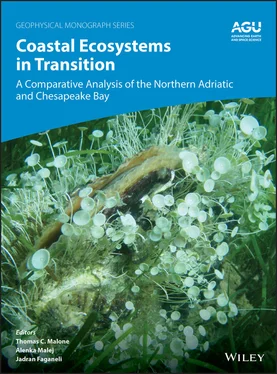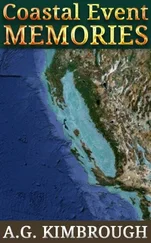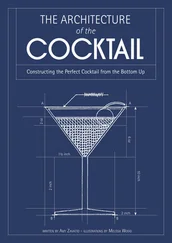15 Chesapeake Bay Program (2014). Chesapeake Bay Watershed Agreement. https://www.chesapeakebay.net/what/what_guides_us/watershed_agreement
16 Chesapeake Executive Council (1988). Baywide nutrient reduction strategy: An agreement commitment report. Annapolis, MD.
17 Cirmo, C.P., & McDonnell, J.J. (1997). Linking the hydrologic and biogeochemical controls of nitrogen transport in near‐stream zones of temperate‐forested catchments: A review. Journal of Hydrology, 199(1–2), 88–120. https://doi:10.1016/s0022‐1694(96)03286‐6
18 Cloern, J.E. (2001). Our evolving conceptual model of the coastal eutrophication problem. Marine Ecology Progress Series, 210, 223–253. https://doi:10.3354/meps210223
19 Cozzi, S., Falconi, C., Comici, C., Čermelj, B., Kovac, N., Turk, V., & Giani, M. (2012). Recent evolution of river discharges in the Gulf of Trieste and their potential response to climate changes and anthropogenic pressure. Estuarine, Coastal and Shelf Science, 115, 14–24. https://doi:10.1016/j.ecss.2012.03.005
20 Cozzi, S., & Giani, M. (2011). River water and nutrient discharges in the Northern Adriatic Sea: Current importance and long term changes. Continental Shelf Research, 31(18), 1881–1893. https://doi:10.1016/j.csr.2011.08.010
21 Cozzi, S., Ibáñez, C., Lazar, L., Raimbault, P., & Giani, M. (2019). Flow regime and nutrient‐loading trends from the largest south European watersheds: Implications for the productivity of Mediterranean and Black Sea’s coastal areas. Water, 11(1), 1. https://doi:10.3390/w11010001
22 Cozzi, S., Mistaro, A., Sparnocchia, S., Colugnati, L., Bajt, O., & Toniatti, L. (2014). Anthropogenic loads and biogeochemical role of urea in the Gulf of Trieste. Science of the Total Environment, 493, 271–281. https://doi:10.1016/j.scitotenv.2014.05.148
23 Degobbis, D. (1989). Increased eutrophication of the northern Adriatic sea. Marine Pollution Bulletin, 20(9), 452–457. https://doi:10.1016/0025‐326x(89)90066‐0
24 Diaz, R.J., & Rosenberg, R. (2008). Spreading dead zones and consequences for marine ecosystems. Science, 321(5891), 926–929. https://doi:10.1126/science.1156401
25 Djakovac, T., Degobbis, D., Supić, N., & R. Precali (2012). Marked reduction of eutrophication pressure in the northeastern Adriatic in the period 2000–2009. Estuarine, Coastal and Shelf Science, 115, 25–32. https://doi:10.1016/j.ecss.2012.03.029
26 Eshleman, K.N., Sabo, R.D., & Kline, K.M. (2013). Surface water quality is improving due to declining atmospheric N deposition. Environmental Science and Technology, 47(21), 12193–12200. https://doi:10.1021/es4028748
27 Focazio, M.J., Plummer, L.N., Bohlke, J.K., Busenberg, E., Bachman, L.J., & Powars, D.S. (1997). Preliminary estimates of residence times and apparent ages of ground water in the Chesapeake Bay watershed, and water‐quality data from a survey of springs (Water‐Resources Investigations Report 97‐4225, 75 pp.). Richmond, VA: US Geological Survey.
28 Forber, K.J., Withers, P.J.A., Ockenden, M.C., & Haygarth, P.M. (2018). The phosphorus transfer continuum: A framework for exploring effects of climate change. Agricultural and Environmental Letters, 3(1). https://doi:10.2134/ael2018.06.0036
29 Frantar, P. (2007). Geographical overview of water balance of Slovenia 1971–2000 by main river basins. Acta Geographica Slovenica, 47, 25–45.
30 Frignani, M., Langone, L., Ravaioli, M., Sorgente, D., Alvisi, F., & Albertazzi, S. (2005). Fine‐sediment mass balance in the western Adriatic continental shelf over a century time scale. Marine Geology, 222–223, 113–133. https://doi:10.1016/j.margeo.2005.06.016
31 Gellis, A.C., Hupp, C.R., Pavich, M.J., Landwehr, J.M., Banks, W.S.L., Hubbard, B. E., et al. (2008). Sources, transport, and storage of sediment at selected sites in the Chesapeake Bay Watershed (Scientific Investigations Report 2008‐5186, 95 pp.). Reston, VA: US Geological Survey.
32 Giani, M., Djakovac, T., Degobbis, D., Cozzi, S., Solidoro, C., & Umani, S.F. (2012). Recent changes in the marine ecosystems of the northern Adriatic Sea. Estuarine, Coastal and Shelf Science, 115, 1–13. https://doi:10.1016/j.ecss.2012.08.023
33 Glennie, E.B., Littlejohn, C., Gendebien, A., Hayes, A., Palfrey, R. Sivil, D., & Wright, K. (2002). Phosphates and alternative detergent builders—final report (UC4011, 172 pp.). EU Environment Directorate.
34 Hagy, J.D., Boynton, W.R., Keefe, C.W., & Wood, K.V. (2004). Hypoxia in Chesapeake Bay, 1950–2001: Long‐term change in relation to nutrient loading and river flow. Estuaries, 27(4), 634–658. https://doi:10.1007/bf02907650
35 Hirsch, R.M. (2012). Flux of nitrogen, phosphorus, and suspended sediment from the Susquehanna river basin to the Chesapeake Bay during Tropical Storm Lee, September 2011, as an indicator of the effects of reservoir sedimentation on water quality (Scientific Investigations Report 2012‐5185, 17 pp.). Reston, VA: US Geological Survey.
36 Hirsch, R.M., Moyer, D.L., & Archfield, S.A. (2010). Weighted Regressions on Time, Discharge, and Season (WRTDS), with an application to Chesapeake Bay River inputs. Journal of the American Water Resources Association, 46(5), 857–880. https://doi:10.1111/j.1752‐1688.2010.00482.x
37 Hoffmann, C.C., Kjaergaard, C., Uusi‐Kamppa, J., Hansen, H.C., & Kronvang, B. (2009). Phosphorus retention in riparian buffers: Review of their efficiency. Journal of Environmental Quality, 38(5), 1942–1955. https://doi:10.2134/jeq2008.0087
38 House, W.A. (2003). Geochemical cycling of phosphorus in rivers. Applied Geochemistry, 18(5), 739–748. https://doi:10.1016/s0883‐2927(02)00158‐0
39 Jarvie, H.P., Sharpley, A.N., Spears, B., Buda, A.R., May, L., & Kleinman, P.J. (2013). Water quality remediation faces unprecedented challenges from “legacy phosphorus.” Environmental Science and Technology, 47(16), 8997–8998. https://doi:10.1021/es403160a
40 Kemp, W.M., Boynton, W.R., Adolf, J.E., Boesch, D.F., Boicourt, W.C., Brush, G., et al. (2005). Eutrophication of Chesapeake Bay: Historical trends and ecological interactions. Marine Ecology Progress Series, 303, 1–29. https://doi:10.3354/meps303001
41 Kemp, W.M., Testa, J.M. Conley, D.J., Gilbert, D., & Hagy, J.D. (2009). Temporal responses of coastal hypoxia to nutrient loading and physical controls. Biogeosciences, 6(12), 2985–3008. https://doi:10.5194/bg‐6‐2985‐2009
42 Langland, M.J. (2015). Sediment transport and capacity change in three reservoirs, Lower Susquehanna River Basin, Pennsylvania and Maryland, 1900–2012 (Open‐File Report 2014–1235, 18 pp.). Reston, VA: US Geological Survey.
43 Langland, M.J., & Hainly, R.A. (1997). Changes in bottom‐surface elevations in three reservoirs on the lower Susquehanna River, Pennsylvania and Maryland, following the January 1996 flood—implications for nutrient and sediment loads to Chesapeake Bay (34 pp.). Lemoyne, PA: US Geological Survey.
44 Linker, L.C., Batiuk, R.A., Shenk, G.W., & Cerco, C.F. (2013). Development of the Chesapeake Bay Watershed Total Maximum Daily Load allocation. Journal of the American Water Resources Association, 49(5), 986–1006. https://doi:10.1111/jawr.12105
45 Linker, L.C., Dennis, R., Shenk, G.W., Batiuk, R.A., Grimm, J., & Wang, P. (2013). Computing atmospheric nutrient loads to the Chesapeake Bay watershed and tidal waters. Journal of the American Water Resources Association, 49(5), 1025–1041. https://doi:10.1111/jawr.12112
46 Litke, D.W. (1999). Review of phosphorus control measures in the United States and their effects on water quality (43 pp.). Denver, CO: US Geological Survey.
47 Marchetti, R., A. Provini, & G. Crosa (1989). Nutrient load carried by the River Po into the Adriatic Sea, 1968–1987. Marine Pollution Bulletin, 20(4), 168–172. https://doi:10.1016/0025‐326x(89)90487‐6.
Читать дальше












